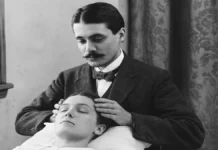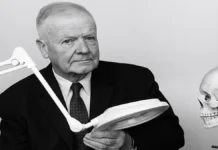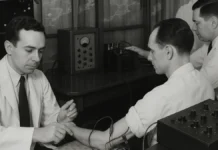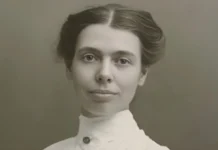Introduction
John Martin Littlejohn, born in 1865 and died in 1947, remains an eminent figure in the history of osteopathy. His fascinating life and considerable impact left an indelible mark on the development of this alternative medical discipline.
Born in Ayr, Scotland, in 1865, Littlejohn dedicated his life to the understanding and promotion of osteopathy. His academic journey took him to the University of Edinburgh, where he studied medicine. However, it was his meeting with the founder of osteopathy, Andrew Taylor Still, in the United States that profoundly influenced his view of health and well-being.
In 1900, alongside his two brothers, James Buchanan Littlejohn and David Littlejohn, John Martin Littlejohn co-founded The Littlejohn Hospital in Chicago, Illinois. This teaching hospital became a cornerstone for the advancement of osteopathic medicine, combining clinical practice with educational initiatives to train future osteopathic physicians. Their collective efforts not only solidified osteopathy’s foundation but also inspired its global reach and recognition as a holistic medical discipline.
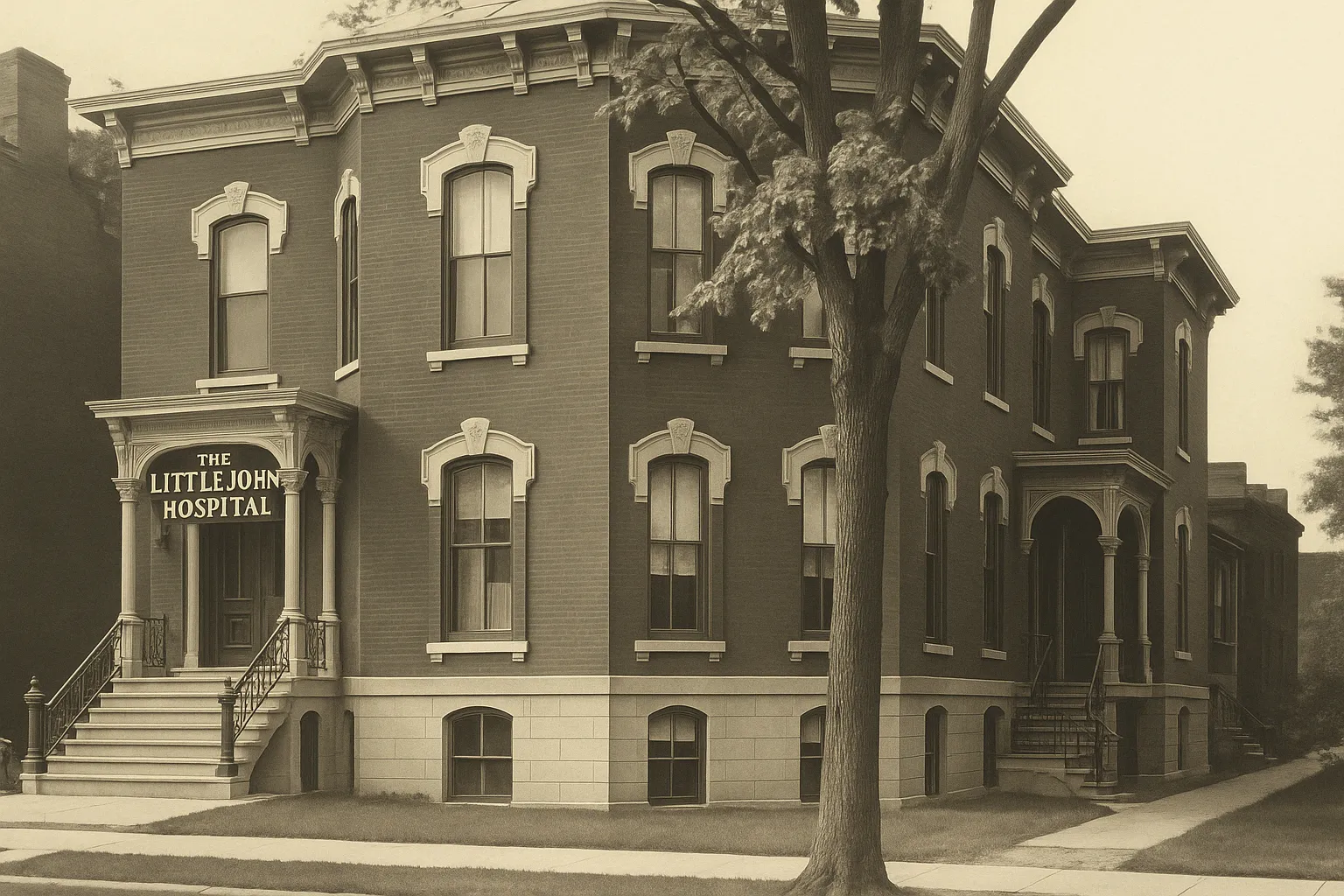
Littlejohn’s Teaching Hospital played a pivotal role in the development of osteopathic medicine, further cementing Chicago’s significance in the history of healthcare. The hospital not only served as a treatment facility but also as a place for medical education, helping to train new generations of healthcare providers. The tranquil setting, with large trees and a peaceful neighborhood, reflected the nurturing environment the hospital aimed to provide for its patients.
After studying with Still, Littlejohn returned to Scotland and established the first school of osteopathy outside the United States, in London, in 1917. This school, known as the “British School of Osteopathy,” played a crucial role in the dissemination and formalization of osteopathy in Europe.
Littlejohn’s contributions to osteopathy are not limited to his educational role. He developed theoretical concepts and practical principles that enriched the discipline. His holistic view of health, emphasizing the structural balance of the body, helped shape the foundations of modern osteopathy.
During his tenure as head of the British School of Osteopathy, Littlejohn trained many practitioners and cemented the school’s reputation as a center of excellence in the field. His influence also extended to his writings, where he shared his innovative ideas on osteopathy, physiology, and the interconnected nature of the human body.
The death of John Martin Littlejohn in 1947 marked the end of an era, but his legacy lives on in the practice and teaching of osteopathy. His exceptional contribution laid the foundation for the continued evolution of this discipline, influencing generations of practitioners that followed. In this introduction, we will explore in more depth the life, key ideas and lasting impact of John Martin Littlejohn on the osteopathic landscape.
Family Origins and Education
John Martin Littlejohn’s family origins and educational background were instrumental in his path to osteopathy, a discipline that would later benefit from his exceptional contributions.
Born in 1865 in Ayr, Scotland, Littlejohn emerged from a family background that potentially influenced his interest in the medical field. Although the precise details of one’s family heritage sometimes remain unclear, it is common to observe medical professionals coming from families with ties to medicine.
His educational journey began at the University of Edinburgh, where he opted to study medicine. This decision was the starting point for his medical career, but it was his experiences in the United States that would significantly shape his future.
His meeting with Andrew Taylor Still, the founder of osteopathy, was a defining moment. Still’s innovative ideas on the holistic approach to the human body captivated Littlejohn, leading him to embrace osteopathy as an alternative medical path.
Returning to Europe, Littlejohn established the first osteopathic school outside the United States, the British School of Osteopathy in London, in 1917. His commitment to education greatly contributed to popularizing osteopathy on the continent. European.
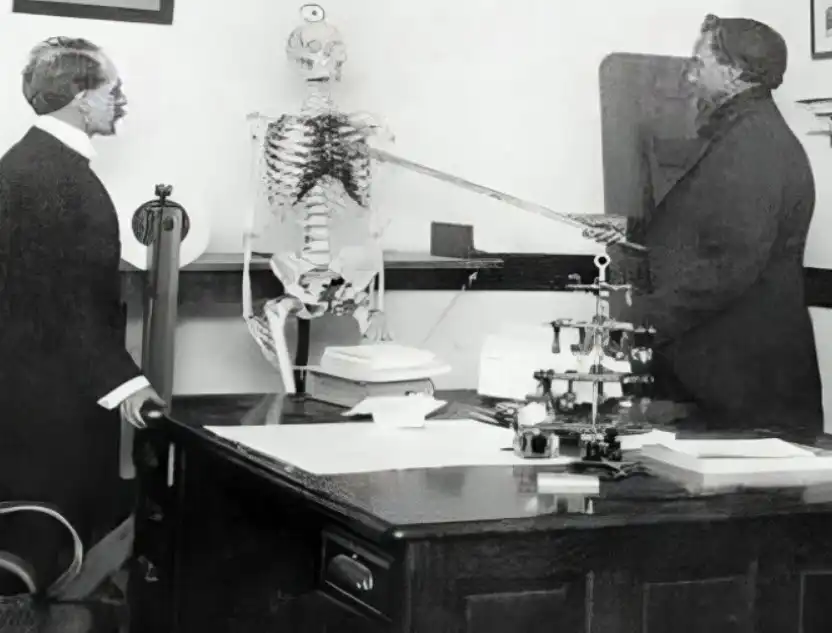
This historic photograph captures a profound moment between John Martin Littlejohn (left), a leading figure in the development of osteopathy, and Andrew Taylor Still (right), the founder of the discipline. Together, they represent two generations of osteopathic pioneers united by their commitment to holistic healthcare and the principles of structural and functional harmony in the human body.
Andrew T. Still, with his revolutionary vision of osteopathy as a drug-free, manual therapy-based system, laid the foundation for a new approach to medicine. His teachings emphasized the body’s innate ability to heal itself when properly aligned and functioning optimally. In this image, Still demonstrates his anatomical expertise, illustrating his unwavering belief in the connection between structure and health.
John M. Littlejohn, one of Still’s most distinguished protégés, expanded on these principles by integrating a rigorous scientific framework into osteopathy. As a scholar and educator, Littlejohn was instrumental in advancing osteopathic education, helping to transform it into a recognized and respected medical discipline worldwide.
This photograph not only commemorates a partnership that shaped the trajectory of osteopathy but also symbolizes a shared dedication to innovation, education, and the holistic care of patients. Their collaboration continues to inspire osteopaths across the globe.
Littlejohn’s family background and education therefore created a rich foundation for his later involvement in osteopathy. This combination of Scottish influences, conventional medical training and an enlightening discovery in the United States shaped an individual whose impact on the history of osteopathy remains significant. In the following sections, we will take a closer look at his specific contributions to this discipline and their lasting influence on the medical field.
The Inspiring Anecdote
While John Martin Littlejohn enjoyed notable success in his practice of osteopathy, his journey was shaped by a burning desire to share his knowledge and passion with generations to come. Convinced that osteopathy represented much more than a simple method of treatment, for him, it was a true philosophy of care. Driven by this deep conviction, Littlejohn nourished the aspiration of creating a dedicated place of learning, where osteopathic principles would be transmitted with rigor and dedication.
Littlejohn’s understanding of osteopathy went far beyond simple medical practice. He considered it a holistic approach, a way of perceiving the human body as a whole, where structure and function were intrinsically linked to health. His belief in the body’s intrinsic power to self-regulate and heal, supported by osteopathic principles, fueled his desire to see these ideas transcend his own practice.
With this vision, Littlejohn aspired to establish a place of education that would embody these fundamental principles. In 1917 he brought this vision to life by founding the British School of Osteopathy in London. This institution would become the cradle of osteopathic education outside the United States, setting high standards for the transmission of osteopathic knowledge.
His goal was clear: to create an environment where students could not only learn osteopathic techniques, but also internalize the philosophy behind them. Littlejohn wanted to instill in his students a deep respect for the complexity and interconnectedness of the human body, encouraging a thoughtful and individualized approach to the practice of osteopathy.
The “British School of Osteopathy” thus played an essential role in the dissemination and legitimization of osteopathy in Europe. It became the crucible where Littlejohn’s vision and passion were passed on to future generations of practitioners. The establishment helped to train osteopaths imbued with the philosophy of care deeply rooted in the principles laid down by Littlejohn.
Thus, John Martin Littlejohn’s initiative to create a place of learning dedicated to osteopathy testifies to his visionary vision and his unwavering commitment to the transmission of this medical art. His legacy lives on in the lasting influence he had on the teaching and practice of osteopathy in Europe and beyond.
John Martin Littlejohn’s visionary vision in the field of osteopathy found concrete expression with the founding of the Chicago College of Osteopathy in 1900. For him, this school was not simply an educational institution, but rather a temple of knowledge dedicated to osteopathy. His ambitious dream was to create an educational institution that went beyond the simple transmission of technical skills, to train practitioners deeply imbued with the fundamental values of this alternative medical discipline.
The Chicago College of Osteopathy was established as a place where osteopathy would be taught with academic rigor and unwavering devotion to the founding principles of this medical approach. For Littlejohn, the school was not just a means of imparting knowledge, but a nursery where osteopathic philosophy would take root in the minds of students, shaping their deep understanding of health and healing.
Littlejohn’s goal was to educate a new generation of practitioners capable of applying osteopathic principles in an integrated manner, considering the human body in its entirety. He sought to instill in his students a respect for the complexity and interconnectivity of the body, encouraging a holistic approach to the practice of osteopathy.
The creation of the Chicago College of Osteopathy also reflected Littlejohn’s belief in the need to formalize and legitimize osteopathy as a recognized medical discipline. At a time when osteopathy was still finding its place in the medical landscape, Littlejohn laid the foundations of an institution that would contribute to the growth and recognition of this practice.
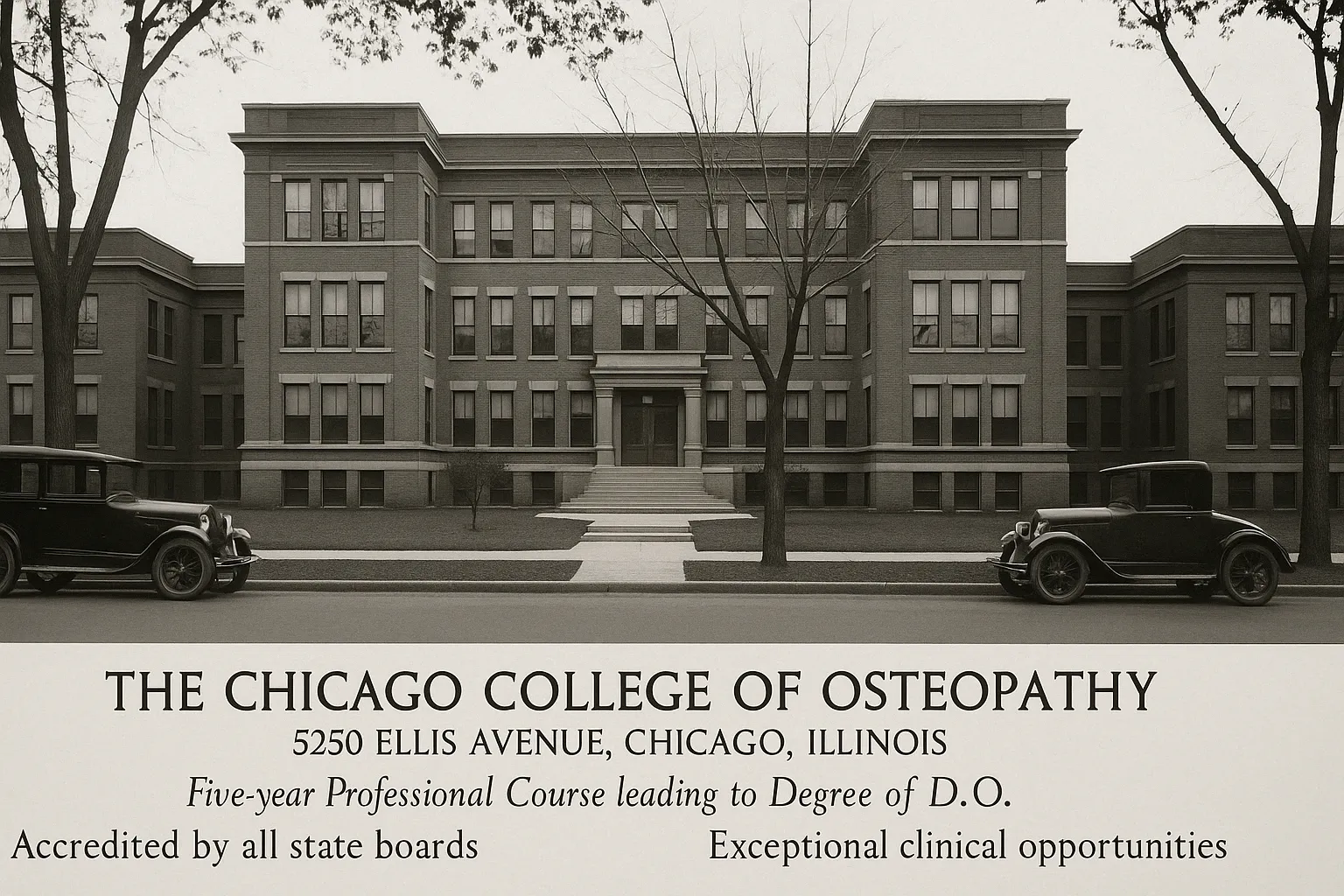
The Chicago College of Osteopathy, pictured here at 5250 Ellis Avenue, Chicago, Illinois, stands as a historic monument to the foresight and determination of John Martin Littlejohn. A true visionary in the field of osteopathy, Littlejohn founded this institution to advance the education and practice of osteopathy as a holistic and science-based approach to healthcare.
Established with a rigorous five-year professional course leading to the Doctor of Osteopathy (D.O.) degree, the college quickly gained recognition for its excellence. Accredited by all state boards, it became a beacon for aspiring osteopaths and a testament to Littlejohn’s unwavering commitment to integrating anatomical, physiological, and mechanical principles into medical training.
Under Littlejohn’s guidance, the Chicago College of Osteopathy emphasized exceptional clinical opportunities, preparing graduates to approach patient care with precision and compassion. His legacy not only transformed osteopathic education in the United States but also laid the foundation for global expansion, influencing osteopathic medicine in Europe and beyond.
This image encapsulates more than just a building; it symbolizes Littlejohn’s enduring impact on osteopathy—a reminder of his dedication to advancing healthcare and his role as a pioneer whose influence continues to inspire osteopaths worldwide.
The choice of Chicago as the location for the school was not insignificant. The city was a thriving center of medical and scientific activity at the time, providing an environment conducive to the emergence and acceptance of new medical approaches. Thus, the Chicago College of Osteopathy was part of this dynamic, becoming an educational beacon that would shine beyond the city’s borders.
In short, the creation of the Chicago College of Osteopathy by John Martin Littlejohn represents a crucial chapter in the history of osteopathy. This educational establishment has not only helped to train competent practitioners, but has also been the vector of osteopathic philosophy, thus shaping the future of this alternative medical discipline. Littlejohn thus laid the foundations of an institution whose influence extended well beyond his time, contributing significantly to the legitimization and propagation of osteopathy.
Conclusion: Honoring the Legacy of John Martin Littlejohn
John Martin Littlejohn’s journey was one of vision, resilience, and groundbreaking contributions to the field of osteopathy. His life and work serve as a testament to the power of interdisciplinary thinking and dedication to holistic healthcare. Littlejohn not only carried forward the foundational principles of Andrew Taylor Still but also expanded them, shaping osteopathy into a scientifically rigorous and globally respected discipline.
As a scholar, practitioner, and educator, Littlejohn championed the integration of mechanical, anatomical, and physiological perspectives into osteopathic practice. His establishment of the British School of Osteopathy created a legacy of education and practice that has inspired generations of osteopaths worldwide. He understood that osteopathy was not merely a set of techniques but a philosophy deeply rooted in the interconnectedness of the human body and its innate capacity for healing.
Today, as osteopathy continues to evolve, we stand on the shoulders of visionaries like Littlejohn, whose work reminds us of the importance of blending tradition with innovation. His emphasis on precision, patient-centered care, and lifelong learning resonates in the practices of modern osteopaths and the institutions dedicated to advancing this field.
Reflecting on Littlejohn’s legacy also underscores the timeless relevance of his teachings. As healthcare systems worldwide grapple with complex challenges, the holistic, preventative, and person-centered approach championed by osteopathy offers a beacon of hope. Littlejohn’s life invites us to honor the past while continuing to explore new frontiers in understanding and treating the human body.
In celebrating John Martin Littlejohn, we not only commemorate an individual who significantly shaped osteopathy but also reaffirm our commitment to upholding and advancing the principles he so passionately believed in. His vision for a science-based, patient-focused, and holistic practice serves as a guide for the future of osteopathy and healthcare as a whole.
By carrying forward Littlejohn’s legacy, the osteopathic community honors its rich history and ensures that his contributions remain a source of inspiration for years to come.




